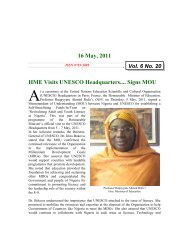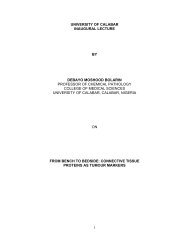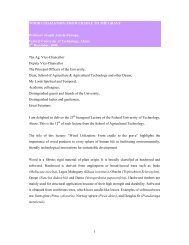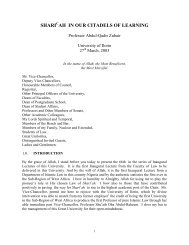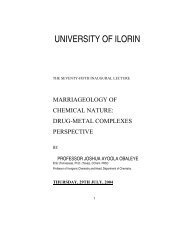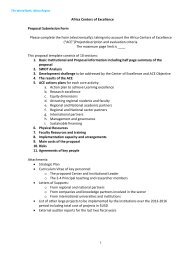THE VARIED ROLES OF SNAILS - National Universities Commission
THE VARIED ROLES OF SNAILS - National Universities Commission
THE VARIED ROLES OF SNAILS - National Universities Commission
Create successful ePaper yourself
Turn your PDF publications into a flip-book with our unique Google optimized e-Paper software.
oth of a direct and an indirect nature. Studies show that<br />
snails have distributional patterns in nature which<br />
strongly correlate with the distribution of specific<br />
aquatic macrophytes for freshwater species (Pimentel<br />
and white, 1959; Sturrock, 1974). It has also been found<br />
that the relationship between snails and plants are often<br />
mutualistic deriving a lot of benefits both ways. The<br />
chemicals produced by plants often attract snails while<br />
the snails themselves develop strategies for locating and<br />
exploiting the plant species. It is now known that plants<br />
derive two major benefits from being eaten by the<br />
snails (especially dead plant materials) namely:<br />
(i) Removal of the dead tissues minimizes the risks of<br />
living tissues becoming invaded by pathogens and<br />
damaged by toxins.<br />
(ii) The consumption of the material by snails increases<br />
the turnover rate of potentially growth limiting<br />
inorganic and organic nutrients for the plants.<br />
In further understanding the ecology of snails, the<br />
quantitative parameters which determine the interactions<br />
between the snails and the non living components of their<br />
environment are important to be known. These interactions<br />
determine the number of species available in the given<br />
habitat at any given time.<br />
Each species of snail in each habitat is known to be<br />
distributed according to the resource patterns in the<br />
environment. Thus each habitat has a theoretical maximum<br />
number of individuals that it can support a phenomenon<br />
referred to earlier as the carrying capacity of the habitat.<br />
37




